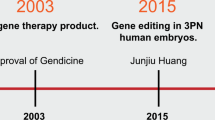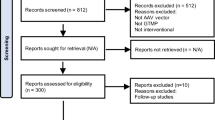Abstract
This is the second part of a review summarizing progress and prospects in gene therapy clinical research. Twenty key diseases/strategies are succinctly described and commented on by leaders in the field. This part includes clinical trials for skin diseases, neurological disorders, HIV/AIDS, ornithine transcarbamylase deficiency, α1-antitrypsin deficiency, haemophilia and cancer.
This is a preview of subscription content, access via your institution
Access options
Subscribe to this journal
Receive 12 print issues and online access
$259.00 per year
only $21.58 per issue
Buy this article
- Purchase on Springer Link
- Instant access to full article PDF
Prices may be subject to local taxes which are calculated during checkout
Similar content being viewed by others
References
Del Rio M, Gache Y, Jorcano JL, Meneguzzi G, Larcher F . Current approaches and perspectives in human keratinocyte-based gene therapies. Gene Ther 2004; 11 (Suppl 1): S57–S63.
Mavilio F, Pellegrini G, Ferrari S, Di Nunzio F, Di Iorio E, Recchia A et al. Correction of junctional epidermolysis bullosa by transplantation of genetically modified epidermal stem cells. Nat Med 2006; 12: 1397–1402.
Harper SQ, Staber PD, He X, Eliason SL, Martins IH, Mao Q et al. RNA interference improves motor and neuropathological abnormalities in a Huntington's disease mouse model. Proc Natl Acad Sci USA 2005; 102: 5820–5825.
Rodriguez-Lebron E, Denovan-Wright EM, Nash K, Lewin AS, Mandel RJ . Intrastriatal rAAV-mediated delivery of anti-huntingtin shRNAs induces partial reversal of disease progression in R6/1 Huntington's disease transgenic mice. Mol Ther 2005; 12: 618–633.
Mittoux V, Ouary S, Monville C, Lisovoski F, Poyot T, Conde F et al. Corticostriatopallidal neuroprotection by adenovirus-mediated ciliary neurotrophic factor gene transfer in a rat model of progressive striatal degeneration. J Neurosci 2002; 22: 4478–4486.
Zala D, Bensadoun JC, Pereira de Almeida L, Leavitt BR, Gutekunst CA, Aebischer P et al. Long-term lentiviral-mediated expression of ciliary neurotrophic factor in the striatum of Huntington's disease transgenic mice. Experimental Neurology 2004; 185: 26–35.
Bloch J, Bachoud-Lévi AC, Déglon N, Lefaucheur JP, Winkel L, Palfi S et al. Neuroprotective gene therapy for Huntington's disease using polymer encapsulated cells engineered to secrete human CNTF: results of a phase I study. Human Gene Therapy 2004; 15: 968–975.
Hefti F . Nerve growth factor promotes survival of septal cholinergic neurons after fimbrial transections. J Neurosci 1986; 6: 2155–2162.
Fischer W, Wictorin K, Bjorklund A, Williams LR, Varon S, Gage FH . Amelioration of cholinergic neuron atrophy and spatial memory impairment in aged rats by nerve growth factor. Nature 1987; 329: 65–68.
Conner JM, Darracq MA, Roberts J, Tuszynski MH . Non-tropic actions of neurotrophins: subcortical NGF gene delivery reverses age-related degeneration of primate cortical cholinergic innervation. Proc Natl Acad Sci USA 2001; 98: 1941–1946.
Tuszynski MH, Thal L, Pay M, Salmon DP, U HS, Bakay R et al. A phase 1 clinical trial of nerve growth factor gene therapy for Alzheimer disease. Nat Med 2005; 11: 551–555.
Arvanitakis Z, Tuszynski MH, Bakay R, Arends D, Potkin S, Bartus R et al. Interim data from a phase 1 clinical trial of AAV-NGF (CERE-110) gene delivery in Alzheimer's disease. American Acad Neurol 2007: Abstract online p05.071.
Levine BL, Humeau LM, Boyer J, MacGregor R-R, Rebello T, Lu X et al. Gene transfer in humans using a conditionally replicating lentiviral vector. PNAS 2006; 103: 17372–17377.
Macpherson JL, Boyd MP, Arndt AJ, Todd AV, Fanning GC, Ely JA et al. Long-term survival and concomitant gene expression of ribozyme-transduced CD4+ T lymphocytes in HIV-infected patients. J Gene Med 2005; 7: 552–564.
Kohn DB, Bauer G, Rice CR, Rothschild JC, Carbonaro DA, Valdez P et al. A clinical trial of retroviral-mediated transfer of a Rev-responsive element decoy gene into CD34 cells from the bone marrow of human immunodeficiency virus-1-infected children. Blood 1999; 94: 279–287.
Podsakoff GM, Engel BC, Barbonaro DA, Choi C, Smogorzewska EM, Bauer G et al. Selective survival of peripheral blood lymphocytes in children with HIV-1 following delivery of an anti-HIV gene to bone marrow CD34+ cells. Mol Therapy 2005; 12: 77–86.
Brock CS, Newlands ES, Wedge SR, Bower M, Evans H, Colquhoun I et al. Phase I trial of temozolomide using an extended continuous oral schedule. Cancer Res 1998; 58: 4363–4367.
Stratford-Perricaudet LD, Levrero M, Chasse JF, Perricaudet M, Briand P . Evaluation of the transfer and expression in mice of an enzyme-encoding gene using a human adenovirus vector. Hum Gene Ther 1990; 1: 241–256.
Raper SE, Yudkoff M, Chirmule N, Gao GP, Nunes F, Haskal ZJ et al. A pilot study of in vivo liver-directed gene transfer with an adenoviral vector in partial ornithine transcarbamylase deficiency. Hum Gene Ther 2002; 13: 163–175.
Raper SE, Chirmule N, Lee FS, Wivel NA, Bagg A, Gao GP et al. Fatal systemic inflammatory response syndrome in a ornithine transcarbamylase deficient patient following adenoviral gene transfer. Mol Genet Metab 2003; 80: 148–158.
Moscioni D et al. Long-term correction of ammonia metabolism and prolonged survival in ornithine transcarbamylase-deficient mice following liver-directed treatment with adeno-associated viral vectors. Mol Ther 2006; 14: 25–33.
Roth DA, Tawa Jr NE, O'Brien JM, Treco DA, Selden RF . Nonviral transfer of the gene encoding coagulation factor VIII in patients with severe hemophilia A. N Engl J Med 2001; 344: 1735–1742.
Powell JS, Ragni MV, White II GC, Lusher JM, Hillman-Wiseman C, Moon TE et al. Phase 1 trial of FVIII gene transfer for severe hemophilia A using a retroviral construct administered by peripheral intravenous infusion. Blood 2003; 102: 2038–2045.
Manno CS, Pierce GF, Arruda VR, Glader B, Ragni M, Rasko JJ et al. Successful transduction of liver in hemophilia by AAV-Factor IX and limitations imposed by the host immune response. Nat Med 2006; 12: 342–347.
Xu L, Gao C, Sands MS, Cai SR, Nichols TC, Bellinger DA et al. Neonatal or hepatocyte growth factor-potentiated adult gene therapy with a retroviral vector results in therapeutic levels of canine factor IX for hemophilia B. Blood 2003; 101: 3924–3932.
Arruda VR, Stedman HH, Nichols TC, Haskins ME, Nicholson M, Herzog RW et al. Regional intravascular delivery of AAV-2-F.IX to skeletal muscle achieves long-term correction of hemophilia B in a large animal model. Blood 2005; 105: 3458–3464.
Nathwani AC, Gray JT, McIntosh J, Ng CY, Zhou J, Spence Y et al. Safe and efficient transduction of the liver after peripheral vein infusion of self-complementary AAV vectors results in stable therapeutic expression of human FIX in nonhuman primates. Blood 2007; 109: 1414–1421.
Muul LM, Tuschong LM, Soenen SL, Jagadeesh GJ, Ramsey WJ, Long Z et al. Persistence and expression of the adenosine deaminase gene for 12 years and immune reaction to gene transfer components: long-term results of the first clinical gene therapy trial. Blood 2003; 101: 2563–2569.
Aiuti A, Vai S, Mortellaro A, Casorati G, Ficara F, Andolfi G et al. Immune reconstitution in ADA-SCID after PBL gene therapy and discontinuation of enzyme replacement. Nat Med 2002; 8: 423–425.
Aiuti A, Slavin S, Aker M, Ficara F, Deola S, Mortellaro A et al. Correction of ADA-SCID by stem cell gene therapy combined with nonmyeloablative conditioning. Science 2002; 296: 2410–2413.
Gaspar HB, Bjorkegren E, Parsley K, Gilmour KC, King D, Sinclair J et al. Successful reconstitution of immunity in ADA-SCID by stem cell gene therapy following cessation of PEG-ADA and use of mild preconditioning. Mol Ther 2006; 14: 505–513.
Engel BC, Podsakoff GM, Ireland JL, Smogorzewska EM, Carbonaro DA, Wilson K et al. Prolonged pancytopenia in a gene therapy patient with ADA-deficient SCID and trisomy 8 mosaicism: a case report. Blood 2007; 109: 503–506.
Aiuti A, Cassani B, Andolfi G, Mirolo M, Biasco L, Recchia A et al. Multilineage hematopoietic reconstitution without clonal selection in ADA-SCID patients treated with stem cell gene therapy. J Clin Invest 2007; 117: 2233–2240.
Gattinoni L, Powell Jr DJ, Rosenberg SA, Restifo NP . Adoptive immunotherapy for cancer: building on success. Nat Rev Immunol 2006; 6: 383–393.
Nestle FO, Farkas A, Conrad C . Dendritic-cell-based therapeutic vaccination against cancer. Curr Opin Immunol 2005; 17: 163–169.
Hanks BA, Jiang J, Singh RA, Song W, Barry M, Huls MH et al. Re-engineered CD40 receptor enables potent pharmacological activation of dendritic-cell cancer vaccines in vivo. Nat Med 2005; 11: 130–137.
Morgan RA, Dudley ME, Wunderlich JR, Hughes MS, Yang JC, Sherry RM et al. Cancer regression in patients after transfer of genetically engineered lymphocytes. Science 2006; 314: 126–129.
Hsu C, Hughes MS, Zheng Z, Bray RB, Rosenberg SA, Morgan RA . Primary human T lymphocytes engineered with a codon-optimized IL-15 gene resist cytokine withdrawal-induced apoptosis and persist long-term in the absence of exogenous cytokine. J Immunol 2005; 175: 7226–7234.
Small EJ, Carducci MA, Burke JM, Rodriguez R, Fong L, van Ummersen L et al. A phase I trial of intravenous CG7870, a replication-selective, prostate-specific antigen-targeted oncolytic adenovirus, for the treatment of hormone-refractory, metastatic prostate cancer. Mol Ther 2006; 14: 107–117.
Hu JC, Coffin RS, Davis CJ, Graham NJ, Groves N, Guest PJ et al. A phase I study of oncoVEXGM-CSF, a second-generation oncolytic herpes simplex virus expressing granulocyte macrophage colony-stimulating factor. Clin Cancer Res 2006; 12: 6737–6747.
Mastrangelo MJ, Maguire Jr HC, Eisenlohr LC, Laughlin CE, Monken CE, McCue PA et al. Intratumoral recombinant GM-CSF-encoding virus as gene therapy in patients with cutaneous melanoma. Cancer Gene Ther 1999; 6: 409–422.
Hotte SJ, Lorence RM, Hirte HW, Polawski SR, Bamat MK, O'Neil JD et al. An optimized clinical regimen for the oncolytic virus PV701. Clin Cancer Res 2007; 13: 977–985.
Forsyth P, Roldan G, George D, Wallace C, Morris D, Cairncross J et al. A phase I trial of intratumoral (i.t.) administration of reovirus in patients with histologically confirmed recurrent malignant gliomas (MGs). ASCO 2006, pp 1563.
Niculescu-Duvaz I, Springer CJ . Introduction to the background, principles, and state of the art in suicide gene therapy. Mol Biotechnol 2005; 30: 71–88.
Braybrooke JP, Slade A, Deplanque G, Harrop R, Madhusudan S, Forster MD et al. Phase I study of MetXia-P450 gene therapy and oral cyclophosphamide for patients with advanced breast cancer or melanoma. Clin Cancer Res 2005; 11: 1512–1520.
Rainov NG . A phase III clinical evaluation of herpes simplex virus type 1 thymidine kinase and ganciclovir gene therapy as an adjuvant to surgical resection and radiation in adults with previously untreated glioblastoma multiforme. Hum Gene Ther 2000; 11: 2389–2401.
Freytag SO, Stricker H, Movsas B, Kim JH . Prostate cancer gene therapy clinical trials. Mol Ther 2007; 15: 1042–1052.
Author information
Authors and Affiliations
Corresponding author
Additional information
Eric Alton, Stefano Ferrari and Uta Griesenbach (Progress and Prospects Series Editors)
Rights and permissions
About this article
Cite this article
Griesenbach, U. Progress and Prospects: Gene Therapy Clinical Trials (Part 2). Gene Ther 14, 1555–1563 (2007). https://doi.org/10.1038/sj.gt.3303033
Received:
Accepted:
Published:
Issue Date:
DOI: https://doi.org/10.1038/sj.gt.3303033
Keywords
This article is cited by
-
Exosomes and their Application in Biomedical Field: Difficulties and Advantages
Molecular Neurobiology (2018)
-
Cognitive Enhancement and the Principle of Need
Neuroethics (2015)
-
Chlorotoxin-conjugated nanoparticles as potential glioma-targeted drugs
Journal of Neuro-Oncology (2012)
-
Physiological and tissue-specific vectors for treatment of inherited diseases
Gene Therapy (2011)
-
Immune responses to adeno-associated virus type 2 encoding channelrhodopsin-2 in a genetically blind rat model for gene therapy
Gene Therapy (2011)



